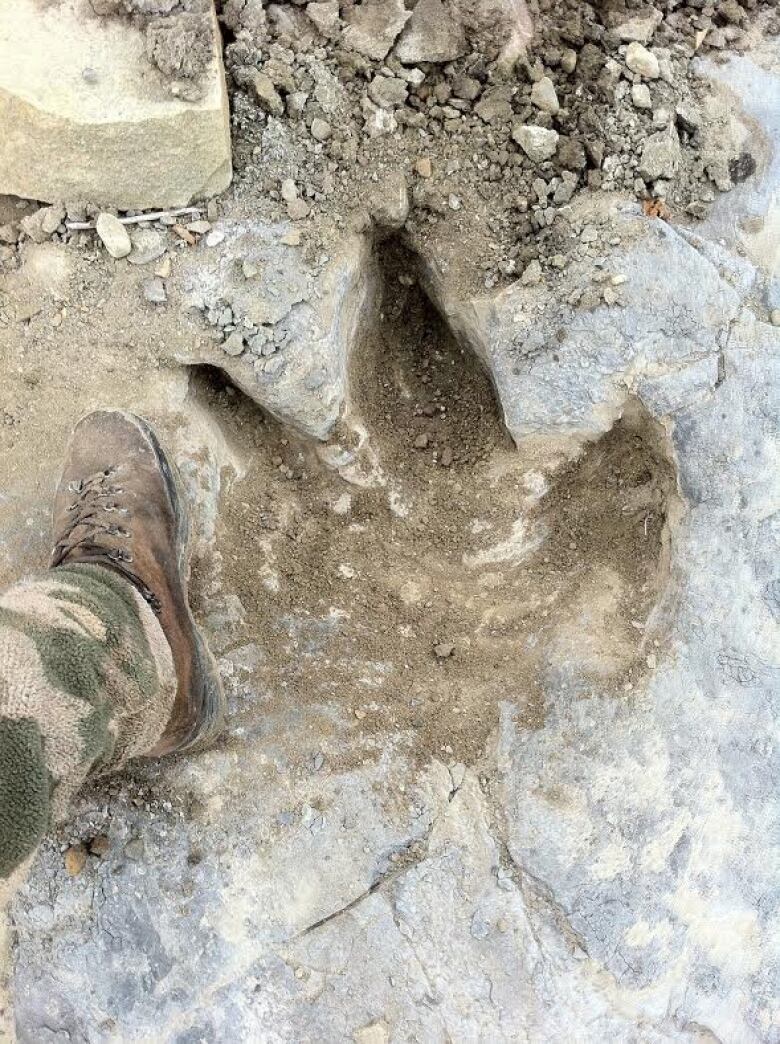
It would have been terrifying to run into a tyrannosaur like Albertosaurus. The massive creature that roamed western North America about 70 million years ago was as long as a bus, with a wide smile of razor-sharp teeth and claws to match. But here’s the worst part — it probably wasn’t alone.
Tyrannosaurs, it seemed, travelled in packs.
Scientists came to that conclusion after carefully analyzing an extremely rare find — three sets of tyrannosaur tracks found in northeastern B.C.

Tyrannosaur tracks are so rare that this is the first time more than a single print has ever been found in one place.
That made the discovery exciting to begin with, since it allows paleontologists to see how the animal walked, said Richard McCrea, lead author of a new study in the journal PLOS ONE describing the tracks.

Moose hunting trip
The fossil tracks were discovered in the fall of 2011 by Aaron Fredlund, a hunting guide in Tumbler Ridge, B.C. He was guiding a group of moose hunters and looking for a place to cross a river when he spied a promising looking rock ledge.
Fredlund said he spends all day looking for animal tracks as part of his job. He had never seen dinosaur tracks himself, but knew others had been found in the region.

“We just walked along, and I thought, ‘This looks kind of like the pictures where they find dinosaur tracks.’ And I didn’t even take four steps, and I was like, ‘Look, there’s a dinosaur track!’” Fredlund recalled in a phone interview.
The print was enormous — made by a three-toed foot more than 60 centimetres long.
Fredlund’s find was a stroke of luck, as McCrea thinks most people walking by wouldn’t have noticed the tracks.

“If they had noticed them, they probably talked themselves out of identifying them as dinosaur tracks,” added McCrea, curator of palaeontology at the Peace Region Palaeontology Research Centre.
Predictably, Fredlund’s companions didn’t believe him at first. But he poked around and eventually found additional prints, some from the same dinosaur and some from different dinosaur species.
“They’re so clear you can actually see the little contours in their foot,” he said. “They’re pretty amazing tracks.”

A few days later, his wife, Jessica, found the photos he’d taken and asked about them.
“I said, ‘Oh, we saw some dinosaur tracks.’ She said, ‘You’ve got to tell somebody about those!’”
Fredlund phoned around and eventually reached someone at the Tumbler Ridge Museum. He shared with them photos of his boots next to the tracks. The museum passed them on to McCrea, who was studying fossil tracks in Australia at the time.

“As soon as I saw them, I wished that I wasn’t in Australia,” said McCrea.
Dinos in their 20s
After he returned to Canada, he and his team rushed to the site to make casts of the prints before the first snowfall. The next year, they did more excavating and found additional tracks.

The three tyrannosaurs that made them had feet of slightly different sizes. Based on the size of their feet, the animals would have stood about 2.5 metres tall at the hip (about the height of a very tall doorway). They would have been 10 to 12 metres long from head to tail, about as long as a bus. McCrea said they would have walked with their spine and tail parallel to the ground.
Based on their size, they likely belonged to one of three tyrannosaurs that lived in B.C. and Alberta at the time — Albertosaurus, Gorgosaurus and Daspletosaurus.
Since tyrannosaurs grow their whole lives, the researchers estimated the animals were all in their late 20s. Fossil evidence suggests that tyrannosaurs lived into their 30s.

4-metre stride
An analysis of the tracks showed the animals had a stride of about four metres, from right footfall to right footfall or left footfall to left footfall.
“And this is at a walk!” said McCrea, who estimated the tyrannosaurs would have been walking at well over eight km/h.
The foot imprints showed that tyrannosaurs retracted their feet up and back like modern birds do between footfalls, but they did not turn their feet inward as much as many birds do as they walked. Tyrannosaurs belong to a group of dinosaurs called theropods that are thought to be closely related to birds.

But the most exciting discovery of all was the confirmation that tyrannosaurs moved in packs. That was something that paleontologists had suggested in the past based on groups of skeletons found together. But they could never be sure that the bones had not been originally scattered and then carried by water to a single location.
With the new trackways, the similar depth and condition of the footprints suggested they were left at the same time — prints left later, as the mud dried, would have been shallower.
Further evidence that the tyrannosaurs were travelling together was that they were all moving in the same direction, and their paths never crossed, unlike those of other dinosaurs found at the side, which moved in random directions.

“It’s about as strong evidence as you can get without going back in a time machine and observing them,” McCrea said.
Fredlund said the discovery of the tracks and what happened to them has been a cool learning experience, and he feels fortunate.
“I’ve told my friends I’m not going to buy any lottery tickets, because finding a dinosaur tracks — one of the only trackways that they’ve ever found — I’ve used up all my luck on that one.”